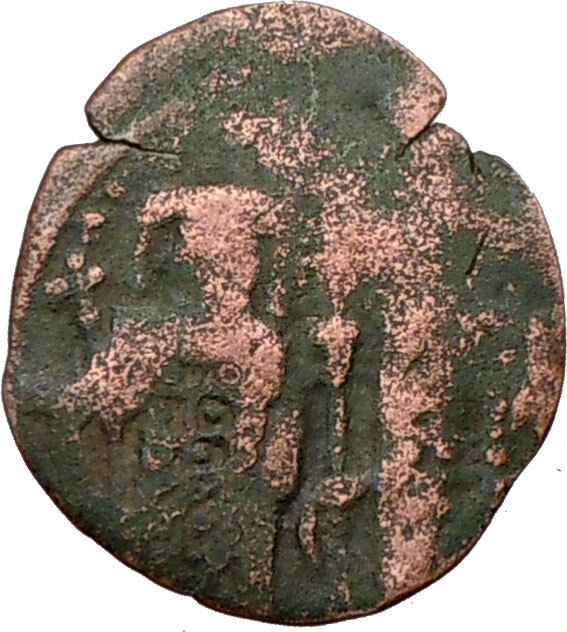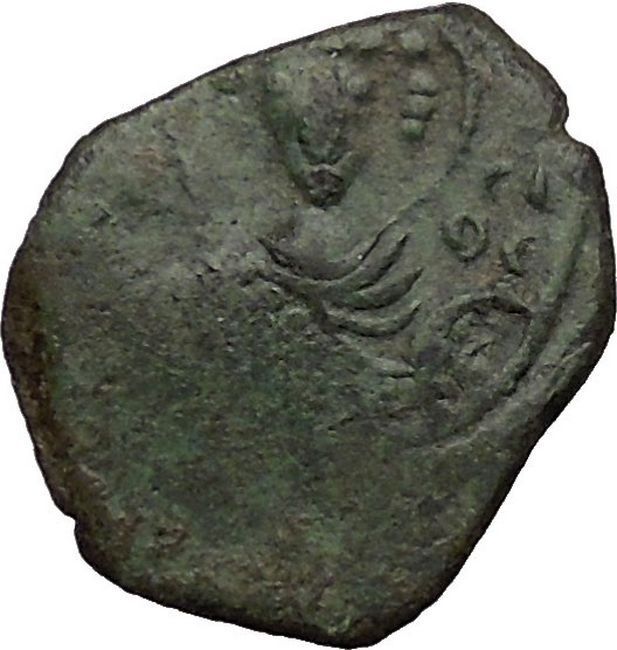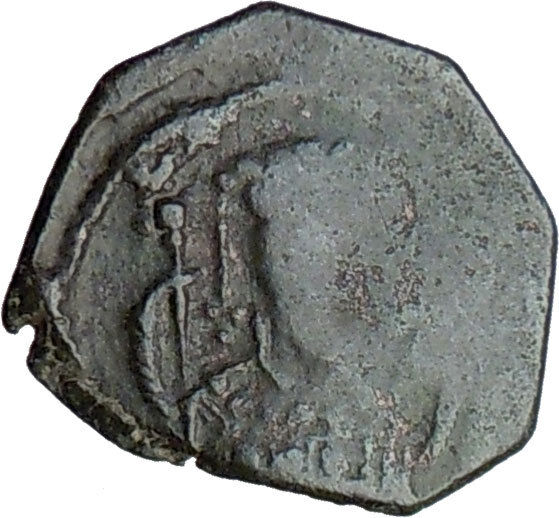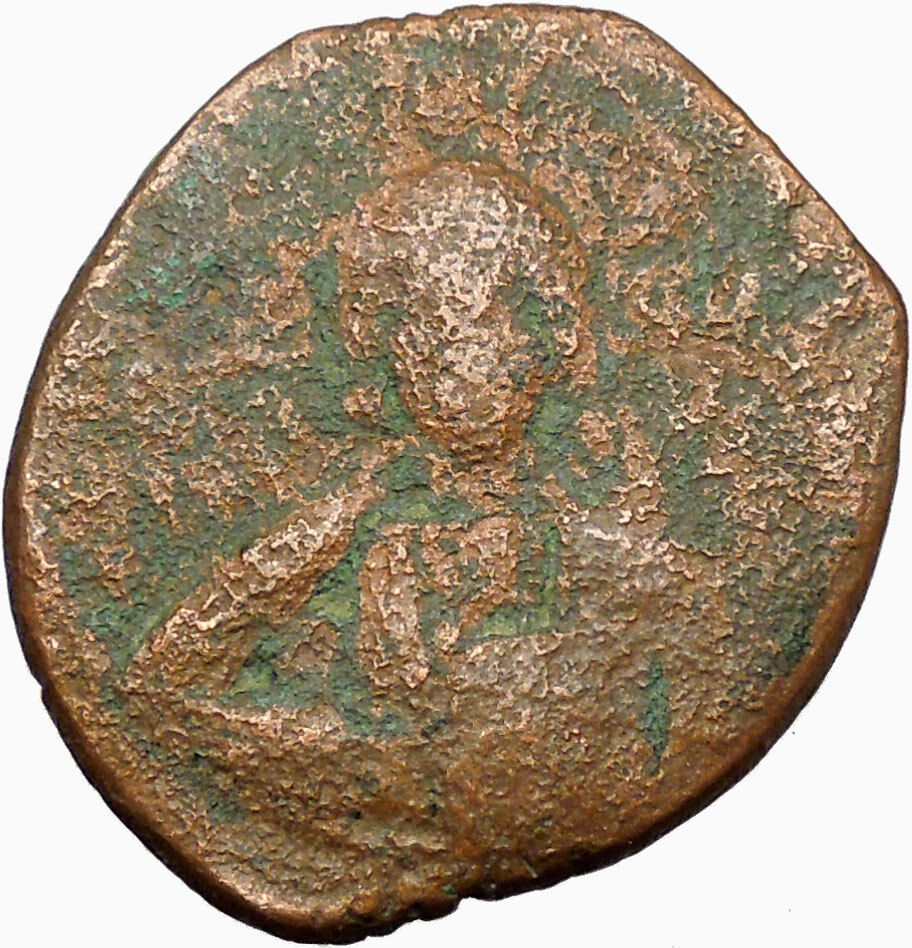|
Byzantine Empire
Phocas – Emperor: November 23, 602 – October 5, 610 A.D.
Gold Solidus 21mm (4.50 grams) Constantinople mint, 10th officina, 607-609 A.D.
Reference: Sear 620
Certification: NGC Ancients MS Strike: 4/5 Surface: 4/5 6055118-001
d N FOCAS-PЄRP AVG, crowned, draped and cuirassed bust of Phocas facing, globus cruciger in right hand.
VICTORIA-AVϚЧ I, Angel standing fcing, long staff terminating in staurogram in right hand, gloabus cruciger in left; CONOB in exergue.
You are bidding on the exact item pictured, provided with a Certificate of Authenticity and Lifetime Guarantee of Authenticity.
Staurogram _I_193_2.jpg/20px-Christliche_Symbolik_(Menzel)_I_193_2.jpg)
The Staurogram (meaning monogram of the cross, from the Greek σταυρός, i.e. cross), or Monogrammatic Cross or Tau-Rho symbol, is composed by a tau (Τ) superimposed on a rho (Ρ). The Staurogram was first used to abbreviate the Greek word for cross in very early New Testament manuscripts such as P66, P45 and P75, almost like a nomen sacrum, and may visually have represented Jesus on the cross.
Ephrem the Syrian in the 4th-century explained these two united letters stating that the tau refers to the cross, and the rho refers to the Greek word “help” which has the numerological value in Greek of 100 as the letter rho has. In such a way the symbol expresses the idea that the Cross saves. The two letters tau and rho can also be found separately as symbols on early Christian ossuaries.
The tau was considered a symbol of salvation due to the identification of the tau with the sign which in Ezekiel 9:4 was marked on the forehead of the saved ones, or due to the tau-shaped outstretched hands of Moses in Exodus 17:11. The rho by itself can refer to Christ as Messiah because Abraham, taken as symbol of the Messiah, generated Isaac according to a promise made by God when he was one hundred years old, and 100 is the value of rho.:158
The Monogrammatic Cross was later seen also as a variation of the Chi Rho symbol, and it spread over Western Europe in the 5th and 6th centuries.
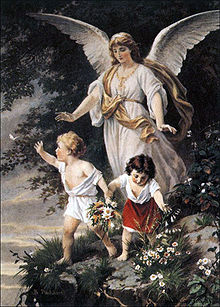 The symbolism of angels has been adopted from the ancient Roman goddess of victory by the early Christians. The goddess transformed into what is known by the Christians as angels via the Christianization of the Roman empire. This is evidenced by many coins still depicting victory, yet of the time period where Christianity was already the official religion of the Roman empire. She appears along with symbols such as a Christogram (also known as a Chi-Rho which is a monogram of Jesus Christ), Staurogram, and the cross, attributing to it’s Christian symbolism. The symbolism of angels has been adopted from the ancient Roman goddess of victory by the early Christians. The goddess transformed into what is known by the Christians as angels via the Christianization of the Roman empire. This is evidenced by many coins still depicting victory, yet of the time period where Christianity was already the official religion of the Roman empire. She appears along with symbols such as a Christogram (also known as a Chi-Rho which is a monogram of Jesus Christ), Staurogram, and the cross, attributing to it’s Christian symbolism.
An angel is a purely spiritual being found in various religions and mythologies. In Abrahamic religions and Zoroastrianism, angels are often depicted as benevolent celestial beings who act as intermediaries between God or Heaven and Earth, or as guardian spirits or a guiding influence. Other roles of angels include protecting and guiding human beings, and carrying out God’s tasks. The term “angel” has also been diversified to various notions of spirits or figures found in many other religious traditions. The theological study of angels is known as “angelology”. In art, angels are often depicted with bird-like wings on their back, a halo, robes and various forms of glowing light.
Phocas (Latin: Flavius Phocas Augustus; Greek: Phokas; 547 – 5 October 610) was Byzantine Emperor from 602 to 610. He usurped the throne from the Emperor Maurice, and was himself overthrown by Heraclius after losing a civil war.
Origins
Phocas was a Greek-speaking native of Thrace. Almost nothing is known of Phocas’s early life and the name of his father is unknown. His mother was named Domentia (or Domentzia). He had at least two brothers, Comentiolus and Domentziolus.
By 600, he was a subaltern officer in the Byzantine army serving in Maurice’s Balkan campaigns, and he was apparently viewed as a leader by his fellow soldiers. He was a member of a delegation sent by the army in that year to Constantinople to submit grievances to the government. The Avars had defeated the Byzantines in 598, had taken a large number of prisoners, and demanded a ransom. Maurice refused to pay and all the prisoners were killed, causing consternation among the army. The delegation’s complaints were rejected, and, according to several sources, Phocas himself was slapped and humiliated by prominent court officials at this time.
Accession
In 602, having created unrest in the legions by reforms intended to reduce the expenses of their maintenance, Maurice ordered the Balkan army, then campaigning against the Avars, to winter on the north side of the Danube, the unprotected far side of the river’s boundary. The army almost immediately revolted and marched on the capital, with Phocas at its head. Within a month, Maurice’s government had collapsed, the Emperor abdicated and fled the city, and the “Green” faction in Constantinople acclaimed Phocas as emperor.
Phocas was crowned in the Church of St. John the Baptist and his wife Leontia was invested with the rank of Augusta. Maurice, who represented little genuine threat, was dragged from his monastic sanctuary at Chalcedon, and killed along with his six sons. It is said that he had to watch as his sons were executed in front of his eyes. The bodies were thrown in the sea and the heads of all were exhibited in Constantinople before Phocas made arrangements for a Christian burial for the relics of his deeply pious predecessor.
Phocas’s rule was broadly welcomed at first because he lowered taxes, which had been high during the reign of Maurice. Fulsome letters of courtly praise from Pope Gregory I attest to this. The pope, Saint Gregory, appreciated his acceptance of the reforms he had begun. The agrarian reforms of the Church in Italy and particularly in Sicily had been followed in Egypt by the Orthodox Patriarchs. The reform consisted in naming “rectores” as administrators of the latifundia and eliminating contractors and parasitic middlemen who exploited the tenant farmers, reducing them to misery and undermining the incomes of the land owners.
The Church needed money to pay for hospitals, maternity wards and orphanages – social infrastructures that the state had left to the clergy. Phocas faced rising opposition and was regarded by many as a “populist”. His coup d’état was the first violent regime change in Constantinople since its foundation by Constantine. He is reported to have responded to this opposition with cruelty, allegedly killing thousands in an effort to keep control of the government. This was probably an exaggeration. No histories written under Phocas survive, and thus we are dependent for information on historians writing under his successors.
Reign
See also: Byzantine-Sasanian War of 602-628 and Byzantine Papacy Column of Phocas, the last monument erected in the Roman forum. Column of Phocas, the last monument erected in the Roman forum.
The Column of Phocas was the last Imperial monument ever to be erected in the Roman forum. In Phocas’s reign, the Byzantines were sovereign over the city of Rome, although the Pope was the most powerful figure resident in the city. Phocas tended to support the popes in many of the theological controversies of the time, and thus enjoyed good relations with the papacy. Phocas gave the Pantheon to Pope Boniface IV for use as a church and intervened to restore Smaragdus to the Exarchate of Ravenna. In gratitude Smaragdus erected in the Roman Forum a gilded statue atop the rededicated “Column of Phocas”, which featured a new inscription on its base in the Emperor’s honour. The fluted Corinthian column and the marble plinth on which it sits were already standing in situ, scavenged previously from yet other monuments.
Despite the popularity Phocas enjoyed early on in his reign, it was during his reign that the traditional frontiers of the Byzantine Empire began to collapse. The Balkans had been pacified under Maurice, the Avars and Slavs having been kept at bay. With the removal of the army from the Danube after 605, the way was paved for new attacks which were to put an end to the Byzantine Balkans. In the east, the situation was grave. The Persian King Khosrau II had been helped onto his throne years earlier by Maurice during a civil war in Persia. Now, he used the death of his erstwhile patron as an excuse to break his treaty with the Empire. He received at his court an individual claiming falsely to be Maurice’s eldest son and co-emperor Theodosius. Khosrau arranged a coronation for this pretender and demanded that the Byzantines accept him as emperor. He also took advantage of the difficulties in the Byzantine military, coming to the aid of Narses, a Byzantine general who refused to acknowledge the new Emperor’s authority and who was besieged by troops loyal to Phocas in Edessa. This expedition was part of a war of attrition Khosrau waged against Byzantine forts in northern Mesopotamia, and by 607 or so he had advanced Persian control to the Euphrates.
The reign of Phocas is also marked by the change of Imperial fashion set by Constantine the Great. Constantine and all his successors, except Julian the Apostate, were beardless. Phocas again introduced the wearing of the beard.
Overthrow and death
In 608, the Exarch of Africa and his son, both named Heraclius, began a revolt against Phocas, issuing coins depicting the two of them in consular (though not imperial) regalia. Phocas responded with executions, among them of the ex-Empress Constantina and her three daughters. Nicetas, a nephew of Heraclius the Elder, led an overland invasion of Egypt; the younger Heraclius began to sail eastward with another force via Sicily and Cyprus. With the outbreak of civil war came serious urban rioting in Syria and Palestine; Phocas sent his general Bonosus to quell the disturbances and reconquer Egypt. Bonosus dealt with the eastern cities so harshly that his severity was remembered centuries later. He then took almost the entire eastern army with him to Egypt, where he was defeated by Nicetas after some hard fighting. The Persians took advantage of this conflict to occupy a significant part of the eastern provinces and even begin a penetration into Anatolia.
By 610, the younger Heraclius had reached the vicinity of Constantinople, and most of the military loyal to Phocas had gone down in defeat or defected. Some prominent Byzantine aristocrats came to meet Heraclius, and he arranged to be crowned and acclaimed as Emperor. When he reached the capital, the Excubitors, an elite Imperial guard unit led by Phocas’s own son-in-law Priscus, deserted to Heraclius, and he entered the city without serious resistance.
Phocas was captured and brought before Heraclius, who asked, “Is this how you have ruled, wretch?”
Phocas replied, “And will you rule better?”
Enraged, Heraclius personally killed and beheaded Phocas on the spot. Phocas’s body was mutilated, paraded through the capital, and burned.
|









_I_193_2.jpg/20px-Christliche_Symbolik_(Menzel)_I_193_2.jpg)
 The symbolism of angels has been adopted from the ancient Roman goddess of victory by the early Christians. The goddess transformed into what is known by the Christians as angels via the Christianization of the Roman empire. This is evidenced by many coins still depicting victory, yet of the time period where Christianity was already the official religion of the Roman empire. She appears along with symbols such as a Christogram (also known as a Chi-Rho which is a monogram of Jesus Christ), Staurogram, and the cross, attributing to it’s Christian symbolism.
The symbolism of angels has been adopted from the ancient Roman goddess of victory by the early Christians. The goddess transformed into what is known by the Christians as angels via the Christianization of the Roman empire. This is evidenced by many coins still depicting victory, yet of the time period where Christianity was already the official religion of the Roman empire. She appears along with symbols such as a Christogram (also known as a Chi-Rho which is a monogram of Jesus Christ), Staurogram, and the cross, attributing to it’s Christian symbolism.  Column of Phocas, the last monument erected in the Roman forum.
Column of Phocas, the last monument erected in the Roman forum.

